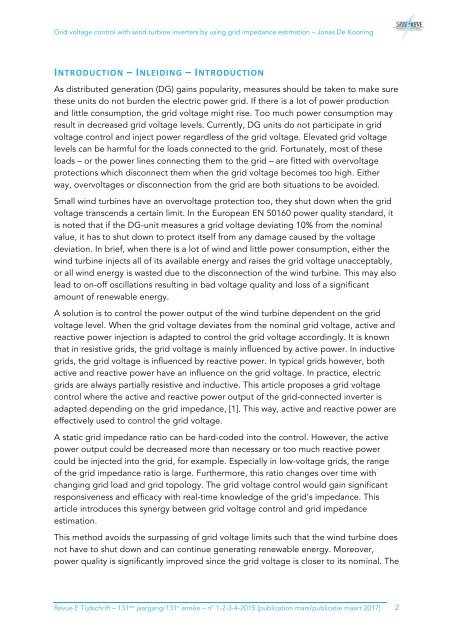RET_2015-01-02-03-04_Flipbook
Create successful ePaper yourself
Turn your PDF publications into a flip-book with our unique Google optimized e-Paper software.
Grid voltage control with wind turbine inverters by using grid impedance estimation – Jonas De Kooning<br />
INTRODUCTION – INLEIDING – INTRODUCTION<br />
As distributed generation (DG) gains popularity, measures should be taken to make sure<br />
these units do not burden the electric power grid. If there is a lot of power production<br />
and little consumption, the grid voltage might rise. Too much power consumption may<br />
result in decreased grid voltage levels. Currently, DG units do not participate in grid<br />
voltage control and inject power regardless of the grid voltage. Elevated grid voltage<br />
levels can be harmful for the loads connected to the grid. Fortunately, most of these<br />
loads – or the power lines connecting them to the grid – are fitted with overvoltage<br />
protections which disconnect them when the grid voltage becomes too high. Either<br />
way, overvoltages or disconnection from the grid are both situations to be avoided.<br />
Small wind turbines have an overvoltage protection too, they shut down when the grid<br />
voltage transcends a certain limit. In the European EN 5<strong>01</strong>60 power quality standard, it<br />
is noted that if the DG-unit measures a grid voltage deviating 10% from the nominal<br />
value, it has to shut down to protect itself from any damage caused by the voltage<br />
deviation. In brief, when there is a lot of wind and little power consumption, either the<br />
wind turbine injects all of its available energy and raises the grid voltage unacceptably,<br />
or all wind energy is wasted due to the disconnection of the wind turbine. This may also<br />
lead to on-off oscillations resulting in bad voltage quality and loss of a significant<br />
amount of renewable energy.<br />
A solution is to control the power output of the wind turbine dependent on the grid<br />
voltage level. When the grid voltage deviates from the nominal grid voltage, active and<br />
reactive power injection is adapted to control the grid voltage accordingly. It is known<br />
that in resistive grids, the grid voltage is mainly influenced by active power. In inductive<br />
grids, the grid voltage is influenced by reactive power. In typical grids however, both<br />
active and reactive power have an influence on the grid voltage. In practice, electric<br />
grids are always partially resistive and inductive. This article proposes a grid voltage<br />
control where the active and reactive power output of the grid-connected inverter is<br />
adapted depending on the grid impedance, [1]. This way, active and reactive power are<br />
effectively used to control the grid voltage.<br />
A static grid impedance ratio can be hard-coded into the control. However, the active<br />
power output could be decreased more than necessary or too much reactive power<br />
could be injected into the grid, for example. Especially in low-voltage grids, the range<br />
of the grid impedance ratio is large. Furthermore, this ratio changes over time with<br />
changing grid load and grid topology. The grid voltage control would gain significant<br />
responsiveness and efficacy with real-time knowledge of the grid's impedance. This<br />
article introduces this synergy between grid voltage control and grid impedance<br />
estimation.<br />
This method avoids the surpassing of grid voltage limits such that the wind turbine does<br />
not have to shut down and can continue generating renewable energy. Moreover,<br />
power quality is significantly improved since the grid voltage is closer to its nominal. The<br />
Revue E Tijdschrift – 131 ste jaargang/131 e année – n° 1-2-3-4-<strong>2<strong>01</strong>5</strong> (publication mars/publicatie maart 2<strong>01</strong>7) 2


